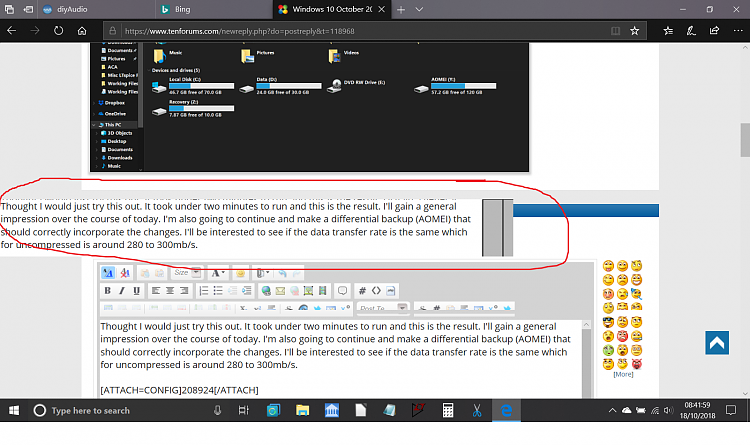New
#1990
Windows 10 October 2018 Update rollout now paused
-
-
New #1991
Why would your Macrium images be redundant? I would have thought any restore would simply bring the OS back to how it was at the time the image was made (meaning the OS would be back to being compressed again). Macrium should also correctly save the change from compressed to non compressed and vice versa in a string of differential or incremental images.
-
New #1992
Thought I would just try this out. It took under two minutes to run and this is the result. I'll gain a general impression over the course of today. I'm also going to continue and make a differential backup (AOMEI) that should correctly incorporate the changes. I'll be interested to see if the data transfer rate is the same which for uncompressed is around 280 to 300mb/s.



AND A WEIRD PROBLEM ALREADY... back in a minute.
-
New #1993
-
New #1994
Just done a restart and differential backup. A lot has changed as can be seen in the last two file sizes. These are separated by just 30 minutes or so. Transfer rate was down, it began at around 200mb and maxed out toward the end at 260mb.
I've no idea on the flashing screen that happened following this experiment other than to say that it has NEVER happened before. Just opened task manager (that took a second or two to open) but generally all is quiet.


-
-
New #1996
Hi folks
If the backup program is taking an image of the Disk the actual data format - i.e the file system used on the Disk won't matter and it can be in any format that's readable -- you can backup Linux XFS partitions or even RAID partitions --. (Restoring RAID is a bit more complex as you have to carefully rebuild the arrays but it can be done).
It won't matter whether OS is compressed or not if you use the stand alone backup / recovery program as it's running in its own OS (probably some sort of WINPE environment).
Where difficulties can arise with these programs - especially for copying things like Linux boot partitions where pointers to actual disk addresses are referenced - is if smart copy is used which is generally done to speed up the whole process.
A slower sector by sector copy will always work whatever the data format at the cost of time and space however - and when restoring non Windows images with things like Macrium you need to ensure the restore is done again sector by sector to the same physical disk or an identical copy.
Cheers
jimbo
-
New #1997
I am not using any compression at all unless I am starving for free space. And now that I am talking about that I think Microsoft's trigger for enabling compactos is just CPU power, because last 5 PCs I installed v1809 on they were all compacted, but one 32GB PC I clean installed yesterday (poor 2-core Celeron processor) wasn't compacted, although it's pretty needed in this case. For my current i7-7700 cpu, winsat cpu -compression shows 889,17 MB/s while disk output (HDD) is 160 MB/s on average (seq. read/write), so maybe I should enable compactos again.
-
New #1998
Wow. I've just read the last 15 or so pages of this thread and all that is going on is people demanding to have their own PoV heard or validated. Actual advice quietened.
Arguing over semantics, also. Thought this place was a reasonable source of information, largely thanks to the staff it probably is. The rest of it is beginning to resemble the Argument Clinic or a Communal Area clique depending on the thread.
-
-
New #1999
CompactOS was introduced for small drives as a wimboot replacement.
I find it hard to believe MS have a deliberate policy to use Compact OS as a means of system performance optimisation. I think OCCAM'S RAZOR principle applies here i.e. the algorithms to decide to use CompactOS are not that good just gets it wrong. PC Technology has moved on since CompactOS was introduced and I bet the algorithms really need to be revisited.
Also, I have heard of people having issues when trying to recover data on another pc, although it should not affect anything. I cannot verify if such is true but I prefer not to take the risk unless essential. It may well be people confusing compactos with compressed drive to be fair.
Related Discussions





